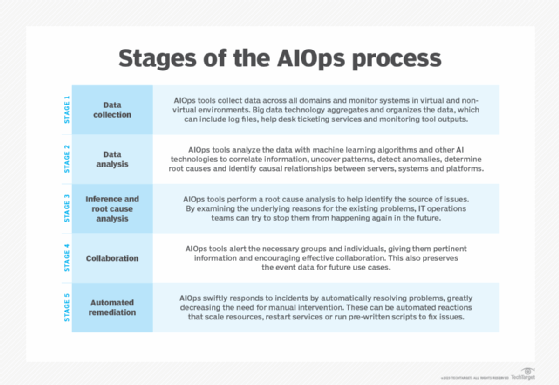
your123 - stock.adobe.com
3 ways to use AI for cloud infrastructure management
Some of the most intensive infrastructure tasks include code generation, monitoring and compliance. Can AI automation improve how cloud admins approach infrastructure management?
Today's cloud administrators are responsible for the complete lifecycle of infrastructure components, including virtual servers, networks, applications and data management from deployment to decommissioning. Automation could offload many of these tasks from admins and enable them to focus on other crucial aspects of infrastructure management.
Infrastructure management is more complex in modern cloud environments, where resources require rapid scaling to frequently meet demands based on different variables. Multi- and hybrid-cloud environments increase the difficulties associated with managing cloud-based infrastructure. Some of the challenges cloud administrators encounter include the following:
- Security.
- Compliance.
- Cost control.
- Performance and optimization.
- Automation.
Add these challenges to the cloud skills gap concerns, and you have a recipe for disaster.
Today, AI presents users with a convenient resolution for nearly any IT challenge -- cloud infrastructure management is no different. According to Flexera's "2025 State of the Cloud Report,"79% of organizations are already using or experimenting with AI and machine learning PaaS services.
Let's examine ways cloud administrators can integrate AI into existing workflows to increase infrastructure management capabilities, specifically in regard to dynamic scaling, AI-generated infrastructure configurations and self-monitoring and self-healing systems.
How AI enables dynamic scaling in cloud infrastructure
AI-based services enable administrators to use data analysis for more responsive and efficient workflows. By providing support for dynamic and automated scaling, AI can either scale up to address traffic spikes and avoid network disruptions or down to save costs and compute power.
Consider the benefits of AI-based dynamic scaling, including the following:
- Predictive scaling. Historical and real-time data can help AI forecast changes in network traffic and usage to further optimize resource scalability.
- Continuous monitoring. Ensures resources are available and AI can adjust to match fluctuations in demand.
- Anomaly detection. This enables AI to predict failures for proactive responses, whether automated or manual.
- Cost management. AI with access to traffic and use data can scale up and down to meet demand and ensure that unnecessary resources aren't wasted, managing costs.
How AI can improve infrastructure configurations
It's commonplace to use AI to generate application-level code using languages such as Python or JavaScript. However, AI can also improve infrastructure as code (IaC) scenarios. Some administrators might use AI to generate IaC resources, while others might rely on AI to validate and analyze files.
Some ways AI can improve IaC management include the following:
- Natural language to code generation. Use natural language queries to generate code to enable less-experienced administrators to work with complex configurations.
- IaC optimization. Validate and analyze existing code resources to ensure they perform at their best.
- Security and compliance. Use AI to scan for misconfigurations and validate configurations in accordance with carefully regulated environments, such as finance or healthcare.
- Knowledge transfer and documentation. AI services, such as Komment, can summarize and document complex code repositories using natural language.
How AI optimizes self-monitoring and self-healing systems
AI provides more effective self-monitoring and self-healing features than cloud administrators could expect in the past. In addition to features like IaC optimization and continuous monitoring, AI can quickly delve into troubleshooting to identify and correct issues.
Some of the benefits of AI's self-monitoring and self-healing systems include the following:
- Root-cause analysis. AI can provide and monitor baselines for resources, streamlining anomaly detection and incident reporting. This prevents infrastructure failures and future downtime.
- Automated remediation. Use AI to automate and speed recovery time. This enhances reliability, helping to keep failures transparent to consumers.
- Predictive maintenance. With the proliferation of IoT devices, AI can use hardware and software data to determine when to conduct maintenance or repairs.
This information enhances the knowledge base from which AI can draw for optimization, compliance, and validation, perpetuating machine learning (ML) and AI capabilities in the infrastructure lifecycle.
AI tools for cloud infrastructure management
Managing the operational aspects of cloud infrastructure entails two different but closely related concepts. The first, cloud artificial intelligence for IT operations (AIOps), uses operational intelligence to maintain availability and automation. The second, generative AI (GenAI), efficiently generates configuration code that supports automated operations.
Let's look at these two concepts in more detail:
- Cloud AIOps. Artificial intelligence for IT operations uses ML and available data to optimize cloud infrastructure and monitoring to enhance decision-making. Consider tools like Fabrix or Dynatrace. Some common use cases include capacity planning, cost optimization and anomaly detection.
- Generative AI. Can create code, configurations, documentation and reports for cloud operations that can help admins manage their infrastructure effectively. Tools like Google Cloud Vertex AI, AWS Bedrock and OpenAI GPT-4 help support generative coding initiatives.

Other AI utilities provide supplementary data or functionality to satisfy specialized aspects of infrastructure management. Consider the following:
- Komment. Distills coding and other projects into informative wikis to streamline onboarding and knowledge transfers. This tool can be especially helpful for managing cloud-based IaC scenarios.
- GitHub Copilot. Provides coding assistance and explanations, enabling developers to focus on problem-solving rather than handling repetitive coding tasks.
Be aware that the lines between these tools might be somewhat blurred. Consider using tools native to your primary cloud infrastructure. AWS, Microsoft Azure and Google Cloud have their own portfolio of AI services. According to Google Cloud's "2025 State of AI infrastructure" report, 48% of organizations acquire and implement GenAI solutions directly from cloud providers, 36% use independent software vendors and 26% develop solutions in-house.
Damon Garn owns Cogspinner Coaction and provides freelance IT writing and editing services. He has written multiple CompTIA study guides, including the Linux+, Cloud Essentials+ and Server+ guides, and contributes extensively to Informa TechTarget, The New Stack and CompTIA Blogs.






